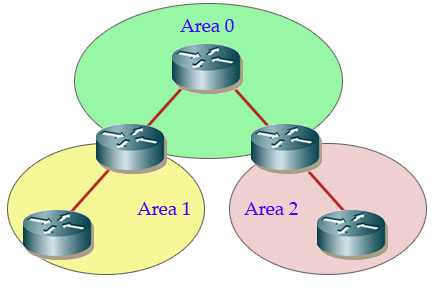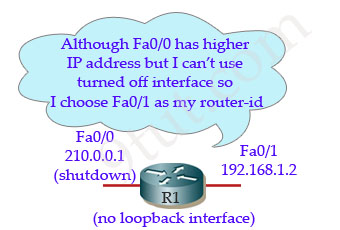OSPF Tutorial
In this article we will learn about the OSPF Routing Protocol
Open-Shortest-Path-First (OSPF) is the most widely used interior gateway protocol routing protocol on the world because it is a public (non-proprietary) routing protocol while its biggest rival, EIGRP, is a Cisco proprietary protocol so other vendors can’t use it (edit: EIGRP has become a public routing protocol since 2013). OSPF is a complex link-state routing protocol. Link-state routing protocols generate routing updates only when a change occurs in the network topology. When a link changes state, the device that detected the change creates a link-state advertisement (LSA) concerning that link and sends to all neighboring devices using a special multicast address. Each routing device takes a copy of the LSA, updates its link-state database (LSDB), and forwards the LSA to all neighboring devices.
Note:
+ OSPF routers use LSA (Link State Advertisement)to describe its link state. LSDB stores all LSAs.
+ A router uses Router LSA to describe its interface IP addresses.
+ After OSPF is started on a router, it creates LSDB that contains one entry: this router’s Router LSA.
There are five types of OSPF Link-State Packets (LSPs).

+ Hello: are used to establish and maintain adjacency with other OSPF routers. They are also used to elect the Designated Router (DR) and Backup Designated Router (BDR) on multiaccess networks (like Ethernet or Frame Relay).
+ Database Description (DBD or DD): contains an abbreviated list of the sending router’s link-state database and is used by receiving routers to check against the local link-state database
+ Link-State Request (LSR): used by receiving routers to request more information about any entry in the DBD
+ Link-State Update (LSU): used to reply to LSRs as well as to announce new information. LSUs contain seven different types of Link-State Advertisements (LSAs)
+ Link-State Acknowledgement (LSAck): sent to confirm receipt of an LSU message
Key points
+ Is a public (non-proprietary) routing protocol.
+ Is the only link-state routing protocol you learn in CCNA
+ This works by using the Dijkstra algorithm
+ Information about its neighbors (local connectivity) is sent to the entire network using multicasting
+ Routing information is shared through Link-state updates (LSAs)
+ HELLO messages are used to maintain adjacent neighbors. By default, OSPF routers send Hello packets every 10 seconds on multiaccess and point-to-point segments and every 30 seconds on non-broadcast multiaccess (NBMA) segments (like Frame Relay, X.25, ATM).
+ Is a classless routing protocol because it does not assume the default subnet masks are used. It sends the subnet mask in the routing update.
+ Supports VLSM and route summarization
+ Uses COST as a metric which CISCO defines as the inverse of the bandwidth
+ Uses AREAs to subdivide large networks, providing a hierarchical structure and limit the multicast LSAs within routers of the same area — Area 0 is called backbone area and all other areas connect directly to it. All OSPF networks must have a backbone area
+ Only support IP but it’s not bad as we are all using IP, right? :)
Area Border Routers (ABR) are any routers that have one interface in one area and another interface in another area
Let’s see an example of OSPF
Suppose OSPF has just been enabled on R1 & R2. Both R1 and R2 are very eager to discover if they have any neighbors nearby but before sending Hello messages they must first choose an OSPF router identifier (router-id) to tell their neighbors who they are. The Router ID (RID) is an IP address used to identify the router and is chosen using the following sequence:
+ The highest IP address assigned to a loopback (logical) interface.
+ If a loopback interface is not defined, the highest IP address of all active router’s physical interfaces will be chosen.
+ The router ID can be manually assigned
In this example, suppose R1 has 2 loopback interfaces & 2 physical interfaces:
+ Loopback 0: 10.0.0.1
+ Loopback 1: 12.0.0.1
+ Fa0/0: 192.168.1.1
+ Fa0/1: 200.200.200.1
As said above, the loopback interfaces are preferred to physical interfaces (because they are never down) so the highest IP address of the loopback interfaces is chosen as the router-id -> Loopback 1 IP address is chosen as the router-id.

Suppose R1 doesn’t have any loopback interfaces but it has 2 physical interfaces:
+ Fa0/0: 210.0.0.1 but it is shut down
+ Fa0/1: 192.168.1.2 (is active)
Although Fa0/0 has higher IP address but it is shutdown so R1 will choose Fa0/1 as its router-id.

Now both the routers have the router-id so they will send Hello packets on all OSPF-enabled interfaces to determine if there are any neighbors on those links. The information in the OSPF Hello includes the OSPF Router ID of the router sending the Hello packet.



Hi everyone check out my website me and my brother are making free CCNA training we already have 2 videos uploaded and working on the rest.
http://www.techpicks.net/free-ccna-training.html
Thank You
Great Job Bro, Thanks a million
Wonderful, a concise way for me to review. Straight and to-the-point thanks!!
thanks buddy…great job done..thanks once again.
Hello,
I have a question. There is a reference to R1, R2, with 192.168.x.x IP addresses. It will be nice if the topology diagram is listed somewhere, I will be able to relate better.
Thanks
hi guys !!
i want to attempt CCNA please help me and suggest dumps
really help full gr8 work dude
To 9tut: New OSPF question about the process of building the adjacency.You must provide the good stage position between Exstart, Exchange, Loading and Full. You have to put these steps in the right postion.
Thank you, nice article.
It would be nice if you could append it and explain the elusive reasons for DR and BDR routers. I’m still not crystal on that.
This is true watson is no longer valid. please send me the valid VCE. Thank you my email is :alexandrodvd8@gmail.com
Hi, can someone send me the last valid VCE to take icnd1 please? Freddybita@gmail.com
Thanks in advance
I’ll take a vice if possible for icnd1 plz. Scheduled exam July 29th. Thx!!!! Celvsmachine@gmail.com
^^^^ * VCE thx
Hello, i am looking for CCNA(200-120) dumps and cracked VCE file. Please help me. My email ID is shahsaurabh_25@yahoo.co.in
god one…
good* one….
hello, what about multi area ospf, v2 v3 is this covered here sorry if it is and i didn’t see it
Hi, Can someone send me the last valid VCE CCNA 200-120 please? armymanpk@yahoo.com
Thanks in advance
Ron
Would somone also send me the latest VCE VVNA 200-120 please? les123@aol.com
Thanks
les123
that should have been CCNA -200-120.
Thanks
les123
Can someone also send my the latest VCE CCNA 200-120 please?
Thanks
ribtip18@gmail.com
This is a great learning forum for network engineers. The information is spot on. I just found this site and is very greatful of the people who put it together. Please keep up the good work team.
Hello, i am looking for CCNA(200-120) dumps and cracked VCE file. Please help me. Email: faithmbugua200@yahoo.com
thanks for this type of information about ospf
Anyone seen any OSPFv3 questions on the 200-120 exams? Specifically, any involving OSPF configurations using IPv6?
Note: DD works like table fo content.
fo should be of !
cheers…
By reading DD, the receiving router can determine what it is missing and them ask the sender to transmit required LSAs..
them should be then :)
I’ve passed CCNA 972 .thanks to 9tut.Aii the bet guys!!!
GOOD…
Hi 9tut
I II test nex week, i need least dump,, plese ,,,send to >> Osmandun7@gmail.com Tanks a lat
Question No. 8 for summarization is not understood properly, can someone explain how ?
Question 6:
Refer to the exhibit. What is the most efficient summarization that R1 can use to advertise its networks to R2?
autosummarize
A. 172.1.0.0/22
B. 172.1.0.0/21
C. 172.1.4.0/22
D. 172.1.4.0/24
172.1.5.0/24
172.1.6.0/24
172.1.7.0/24
E. 172.1.4.0/25
172.1.4.128/25
172.1.5.0/24
172.1.6.0/24
172.1.7.0/24
dear Anonymous
the answer is C 172.1.4.0/22
because that’s prefix 22 have 1022 ip active and then the range ip is 172.1.4.1 until 172.1.7.254 and have network-id = 172.1.4.0 broadcast = 172.1.7.255 , i hope my answere help you CMIIW
Use sign R2 In place of R1 in d second router figure. U have named R1 at 2 places but with different interfaces
Watson data is very usefull. 98% question are from Watson. today I passed ccna exam.
@9tut EIGRP is also now open-standard. Kindly make correction above in OSPF tutorial’s 1st page.
@ImmiRavian: Yes, thanks for your detection. We updated it.
could you modify the name of the Router at the end of the first page ?
When you are talking about the router 2, please write router R2 and not R1 as in your example.
@Anonymous: Thanks for your detection. We have just updated it.
thanks 9tut…..its very helpful to me.